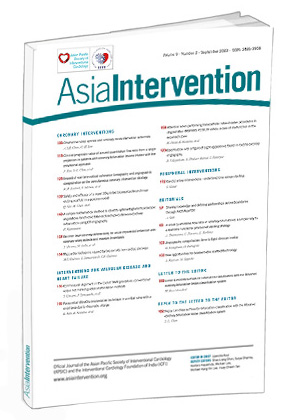Dear friends,
We are delighted to extend a warm welcome to you on behalf of AsiaIntervention, the official journal of AICT-AsiaPCR, and the Interventional Cardiology Foundation of India (ISCL). We look forward to yet another captivating edition here in Singapore.
AsiaIntervention is thrilled to be onsite at AICT-AsiaPCR 2023, ensuring our active participation. At this year’s Fellows Course, we will be present during a PCR clinical research session featuring esteemed speakers Vijay Kunadian and James Howard, who will discuss “Artificial intelligence in medical writing” and “Addressing the unmet needs of our patients through clinical research”.
Throughout the year, AsiaIntervention has actively engaged in a handful of international congresses, including INDIA LIVE 2023 and EuroPCR 2023. While it is crucial for us to be physically present at these gatherings and connect directly with our peers, it is our relentless efforts behind the scenes that contribute significantly to our growth. Building on the success of our inclusion in PubMed Central in 2022, we are proud to announce that we also received our first SCOPUS score in 2023. This achievement further propels us towards our goal. Moreover, we eagerly anticipate our first impact factor, with our application currently in progress. We hope to receive this prestigious recognition in 2024.
Without further ado, we are pleased to present the second volume of 2023. Thank you for your unwavering support which continues to inspire us.
This issue kicks off with coronary interventions and a review of the impact of obstructive sleep apnoea (OSA) on coronary revascularisation outcomes. The article by Adrienne Y.H. Chew and Chi-Hang Lee reports a high incidence of OSA in patients undergoing percutaneous coronary intervention (PCI) or coronary artery bypass graft and suggests that treating OSA could lead to improved outcomes. While routine screening may not be necessary, patients who experience excessive sleep or difficult-to-control hypertension post-revascularisation should be evaluated for OSA.
Jing Kan, Shao-Liang Chen and colleagues present a clinical research article detailing a novel method for estimating a single-plane quantitative flow reserve (μQFR) in the side branch after stenting the main vessel. Their study identifies a μQFR <0.80 in the side branch as a predictor of adverse outcomes, compared to a μQFR>0.80. Antonella Tommasino, Emiliano Navarra and Emanuele Barbato provide insightful comments on the study in an accompanying editorial, highlighting its strengths and limitations.
In another research article, Rony Mathew Kadavil, Vijayakumar Subban and colleagues report on their experience with optical coherence tomography (OCT) and accompanying angiographic coregistration (ACR) in optimising the results of PCI. Their findings demonstrate a significant improvement in outcomes for nearly all patients studied, with excellent results observed at the 1-year mark. The accompanying invited editorial by Giulio Guagliumi and Dario Pellegrini offers expert insights and commentary on the subject.
A translational research article by Qiuping Shi, Ming Chen and colleagues presents a study comparing a three-dimensionally printed sirolimus-eluting bioresorbable vascular scaffold (BRS) to a metallic sirolimus-eluting stent (SES) in a porcine model. The authors evaluate the safety and efficacy of the BRS through periodic OCT and scanning electron microscopic evaluations, spanning 169 days. The study showcases positive remodelling of the BRS without compromising endothelialisation, demonstrating its comparability to metallic SES. Adnan Kastrati and Masaru Seguchi provide an editorial critique, analysing the experimental study's strengths and limitations.
In another translational research article, Hitoshi Kamiunten introduces a method for facilitating chronic total occlusion (CTO) angioplasty using trigonometric vector designs to determine the optimal angulation on standard biplane fluoroscopic equipment. The article outlines the use of a calculator, using spreadsheet software, to minimise dead angles in biplane fluoroscopy, aiding in CTO angioplasty.
The valvular interventions section features an article by Yutaka Konami, Junichi Yamaguchi and colleagues discussing commissural alignment in the Evolut transcatheter aortic valve replacement procedure, comparing conventional and hat marker-guided shaft rotation methods.
In peripheral interventions, an informative review article delves into the long-standing controversy surrounding the treatment of significant carotid disease, comparing non-surgical stenting, surgical endarterectomy, and optimal medical treatment. Sasko Kedev rationalises the subject through a comprehensive review of randomised trials and guidelines. The article emphasises the advancements in stents, embolic protection devices, and technique refinements that have significantly improved the safety and durability of both procedures. While each approach may have advantages in specific situations, successful treatment of severe stenosis, both symptomatic and asymptomatic, is achievable by expert intervention.
This issue also hosts a variety of interventional flashlights, two related to coronary interventions and three to structural interventions. Takashi Hiruma, Mitsuaki Isobe and colleagues present a case of acute myocardial infarction complicated by a large ectasia with a heavy thrombus burden, which was successfully managed using an excimer atherectomy device. Marina S. Guérios, Zeferino Demartini Jr and Enio E. Guérios describe a case of myocardial ischaemia caused by two remote non-cardiac stenoses.
Kento Kito, Ken Kozuma and colleagues showcase a paracentral MitraClip implantation technique in a mitral valve with a small area due to rheumatic aetiology, whilst Hirofumi Hioki, Ken Kozuma and colleagues highlight a transcatheter valve-in-valve procedure in degenerative INSPIRIS RESILIA valves. Ramanathan Velayutham, A. Shaheer Ahmed and Saurav Banerjee explain how they interpreted a calcified figure of eight found on fluoroscopy during routine angiography.
Finally, we have an interesting exchange of letters on coronary bifurcation lesions by Mohammad Reza Movahed and Shao-Ling Chen.
I sincerely hope that the contents of this issue pique your interest and prove beneficial in your daily practice. As always, AsiaIntervention eagerly anticipates your valuable feedback and suggestions, to aid in enhancing the journal even further.
Wishing you a pleasant reading experience!
